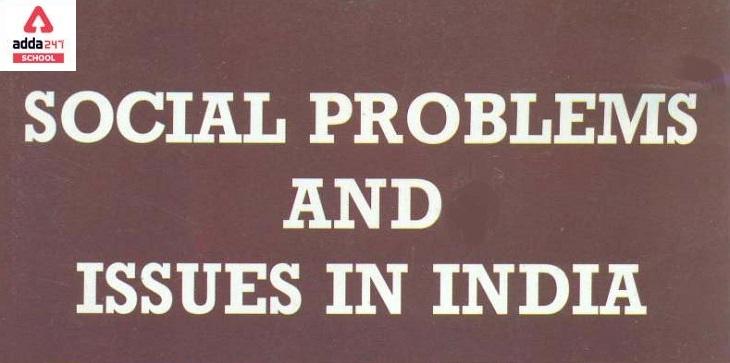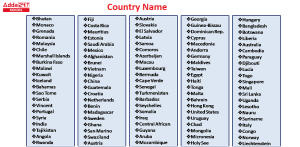Table of Contents
Social Issues in India: Indian society has progressed over time, with advancements in a variety of disciplines. However, there are socio-cultural issues that must be recognised and addressed in every community. People’s safety, particularly that of vulnerable groups such as women, children, and the elderly, is a key issue in modern Indian culture.
Social Issues in India
Casteism, dowry, communalism, drunkenness, drug addiction, and other key socio-cultural concerns need to be addressed today. The topics covered here are not exhaustive. There are other more concerns that the country as a whole, as well as individual regions and communities, must address.
Current Social Issues in India (Political)- Casteism
Castes are rigid and at times even oppressive social groups, in which lifestyle, occupation, and social position are passed down through the generations. The caste system in India dates back to ancient times and has been influenced by numerous ruling elites throughout mediaeval, early modern, and modern India, particularly the Mughal Empire and the British Raj. Varna and jati, the two notions that make up the caste system, can be thought of as separate degrees of analysis.
After gaining independence in 1947, India implemented a number of affirmative action programmes aimed at helping historically underprivileged populations. These measures included reserving a certain number of spots in higher education and government jobs for these groups.
Read About: What is the National Enblem of India?
Social Issues in India- Dowry System
In India, the dowry system refers to the items, such as cash, and permanent or personal property that the bride’s family pays to the groom, his parents, and relatives as a condition of marriage. Dowry is simply a financial payment or a present given to the groom’s family in addition to the bride, and it comprises cash, jewelry, electrical appliances, furniture, bedding, crockery, utensils, vehicles, and other household items that assist the newlyweds in setting up their home. In Arabic, dowry is referred to as Dahez. Dowry is referred to as Aaunnpot in India’s far east.
Read About: Important Amendments of Indian Constitution
Social issues in India- Communalism
The religious and cultural diversity of India gives rise to communalism as a political concept. It has been used as a political propaganda tool to generate divisions, tensions, and divisions amongst groups based on religious and ethnic identity, resulting in communal hatred and violence.
People of various faiths coexisted amicably in ancient Indian civilization.
Perhaps the first Indian prophet to introduce the concept of secularism was Buddha. Meanwhile, kings like Ashoka pursued a policy of religious tolerance and harmony.
The introduction of Islam in medieval India was marked by rare acts of violence, such as the destruction of Hindu temples by Mahmud Ghazni and the attack on Hindus, Jains, and Buddhists by Mahmud of Ghor. While religion played a significant role in people’s lives, there was no community philosophy or politics.
Rulers like Akbar and Sher Shah Suri adopted a religious policy of tolerance for many cultures and traditions practiced throughout the country. Some sectarian kings, such as Aurangzeb, were, nonetheless, among the least tolerant of other religious practices.
It originated as a result of British colonial impact and Indian social strata’s response as a modern phenomenon.
Social issues in India- Gender-Based Discrimination
In every profession, our Constitution guarantees men and women equal rights. Women now have the ability to vote, inherit, and own property. In reality, the Constitution stipulates that the government shall promote the interests of the weaker parts of the population with great attention. Since independence, several laws have been established to advance the interests of women. These rules govern marriage, property inheritance, divorce, and dowry, among other things. The Equal Remuneration Act of 1976 was passed to ensure that men and women were paid equally for equivalent work.
Despite these restrictions, however, we still see a lot of prejudice against women.
In India, women face discrimination in a variety of areas, including health, education, and employment. The girls are responsible for the dowry, and they must leave their parents’ home after marriage. Furthermore, parents desire to produce male offspring in order to protect their old age. Because they are girls, many female babies are aborted, abandoned, purposefully neglected, and underfed.
Social issues in India- Drugs addiction
Drug misuse is frequently accompanied by a negative social impact on the community. The current article focuses on drug abuse’s negative impact on industry, education and training, and the family, as well as its role in the violence, crime, financial difficulties, housing issues, homelessness, and vagrancy.
Social Problems in India
India, being a diverse and populous country, faces a range of social issues. Here are some of the prominent ones:
- Poverty: India has a significant population living below the poverty line, leading to inadequate access to basic necessities like food, clean water, and shelter.
- Gender Inequality: Despite progress, gender disparities still exist in India, including unequal access to education, limited economic opportunities for women, and issues related to gender-based violence.
- Caste System: The caste system, although officially abolished, continues to influence Indian society. Discrimination and violence against lower-caste individuals, often referred to as Dalits, persist.
- Religious Tensions: India is home to multiple religions, and religious tensions and communal violence occasionally arise, particularly between Hindus and Muslims.
- Child Labor: Child labor remains a problem in some parts of India, with children being forced to work in hazardous conditions instead of receiving an education.
- Education Gap: There is a significant gap in the quality of education between urban and rural areas. Many children in rural regions lack access to quality education.
- Healthcare Challenges: Access to healthcare is uneven across the country. Rural areas often lack adequate medical facilities, and healthcare expenses can be a burden for many.
- Corruption: Corruption is prevalent in various sectors, from politics to public services, which hinders economic development and social progress.
- Environmental Issues: Rapid urbanization and industrialization have led to environmental problems such as air pollution, water pollution, and deforestation.
- Overpopulation: India’s population continues to grow, putting pressure on resources and infrastructure, which can exacerbate many of these social problems.
Current Issue in India
Here are some prominent issues:
- COVID-19 Pandemic: India faced significant challenges during the COVID-19 pandemic, including healthcare infrastructure strain, vaccine distribution, and the emergence of new variants.
- Economic Challenges: The Indian economy faced challenges such as job losses, economic contraction, and a slowdown in various sectors due to the pandemic.
- Agricultural Protests: Farmers’ protests against new agricultural laws gained widespread attention and continued to be a major issue in some parts of the country.
- Air Pollution: Major Indian cities, including Delhi, faced severe air pollution, leading to health problems and environmental concerns.
- Political Unrest: Political tensions and debates over various issues, including citizenship laws and regional autonomy, were ongoing.
- Social Issues: India continued to grapple with social issues such as gender inequality, caste-based discrimination, and violence against women.
- Environmental Concerns: Deforestation, wildlife conservation, and water scarcity were some of the environmental issues facing the country.
- Education and Healthcare: Challenges in providing quality education and healthcare to all sections of society remained.
- Cybersecurity: With increasing digitization, India faced cybersecurity challenges, including data breaches and cyberattacks.
- Infrastructure Development: The need for infrastructure development and improving transportation networks continued to be a priority.
Contemporary Issues in India
some key contemporary issues that have been of concern in India:
- COVID-19 Pandemic: India, like the rest of the world, has been dealing with the COVID-19 pandemic. Issues related to healthcare infrastructure, vaccine distribution, and the economic impact of lockdowns have been prominent.
- Economic Challenges: India has faced economic challenges, including job losses, economic inequality, and a need for economic reforms to stimulate growth.
- Environmental Concerns: Environmental issues such as air pollution, deforestation, and climate change have been a growing concern. Air quality in many Indian cities is often poor.
- Farmers’ Protests: In 2020 and 2021, farmers in India protested against new agricultural laws. These protests raised concerns about farmers’ livelihoods and agricultural reforms.
- Religious and Communal Tensions: India has faced communal tensions and religious conflicts in recent years, leading to debates about secularism and religious freedom.
- Education and Digital Divide: The COVID-19 pandemic highlighted the digital divide in education, with many students lacking access to online learning resources.
- Women’s Safety: Women’s safety remains a critical issue, with incidents of violence and harassment leading to discussions about gender equality and legal reforms.
- Cybersecurity and Privacy: As India becomes more digitally connected, concerns about cybersecurity and the protection of personal data have grown.
- Political Issues: Political debates, elections, and issues related to governance and accountability continue to be central to India’s contemporary landscape.
- Healthcare Infrastructure: The pandemic exposed weaknesses in India’s healthcare infrastructure, leading to discussions about the need for improvements and investments.
Top 10 Current Major Problems in India
Top 10 Current major problems in India is given below.
1. Corruption
2. Illiteracy
3. Education System
4. Basic Sanitation
5. Healthcare System
6. Poverty
7. Pollution
8. Women’s Safety
9. Infrastructure
10. Unemployment







 All Country Name List: Know Total 195 Co...
All Country Name List: Know Total 195 Co...
 No 1 School in India- Top 10 School List...
No 1 School in India- Top 10 School List...
 Diwali 2024: Date and Time in India, Che...
Diwali 2024: Date and Time in India, Che...










